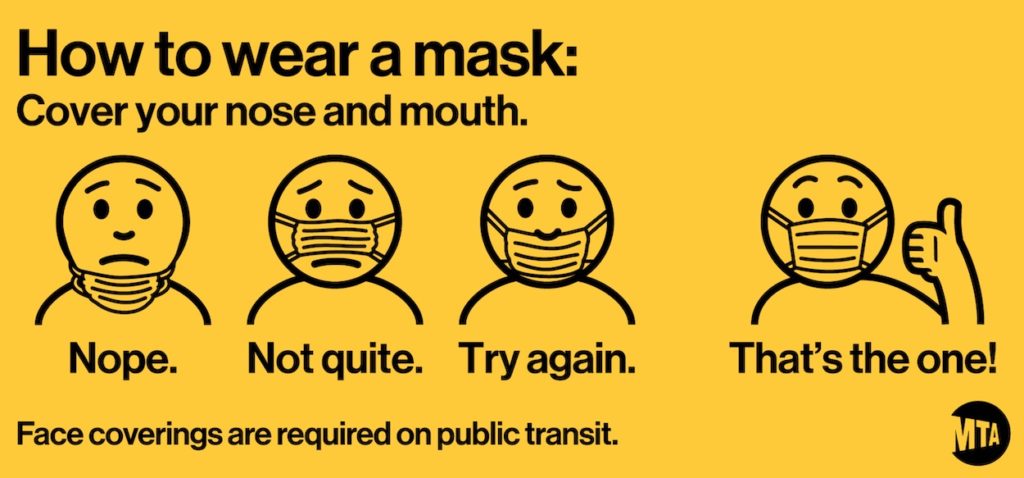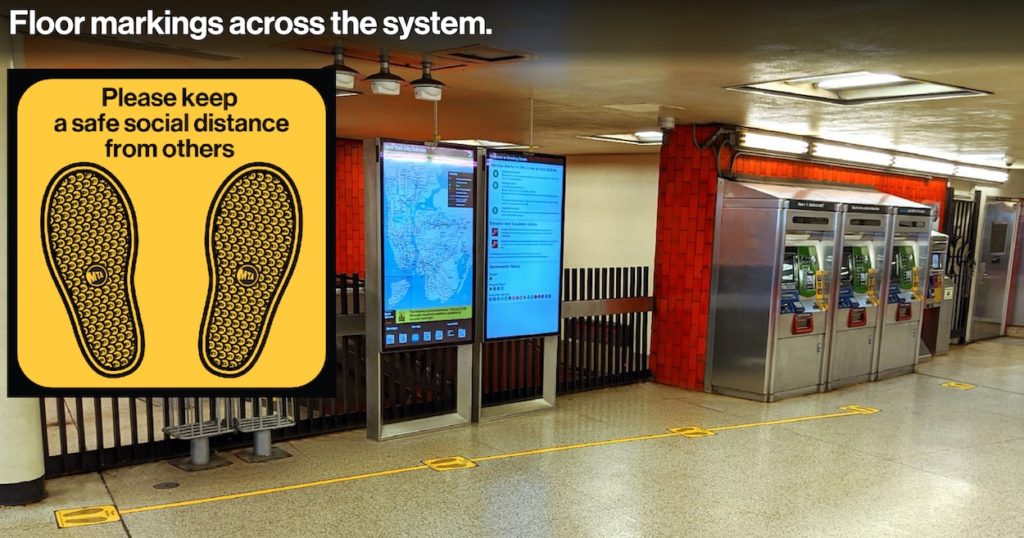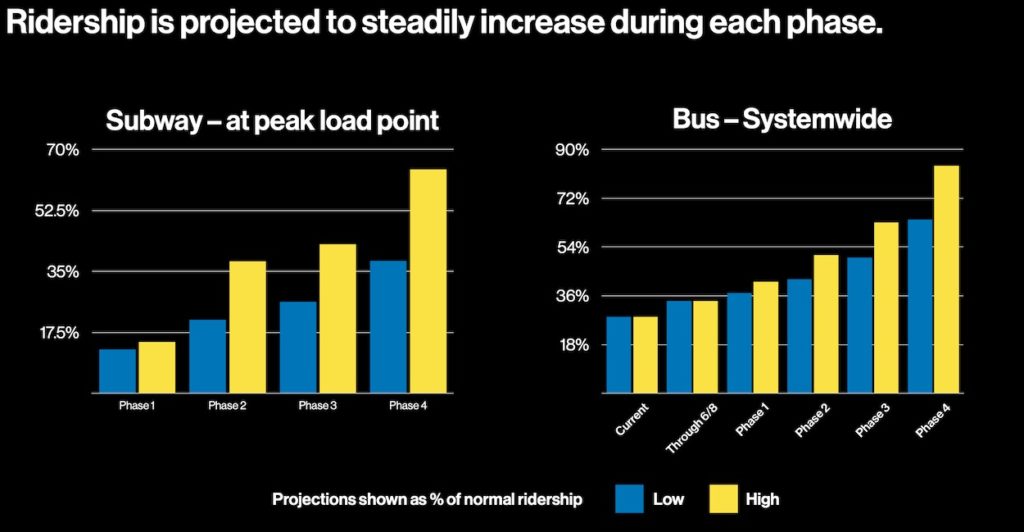
As New York City enters Phase 1 of its reopening, the MTA wants every transit rider to wear masks.
Bill de Blasio is taking a page out of Marie Antoinette’s playbook as New York City loosens pandemic restrictions. While international peer cities have prioritized buses and rolled out hundreds of miles of temporary bike lanes to avert bumper-to-bumper traffic while accommodating commuters who may be hesitant to ride subways in light of social distancing guidelines, the mayor has simply said to his city, “Let them drive cars.” The MTA has a plan to make travel as safe as possible and has asked for rapid deployment of 60 miles of bus lanes, but with business opening in a few hours, the mayor hasn’t used the tools available to him to prioritize transit, leading many advocates to worry about crushing traffic that grinds surface transit — and NYC’s buses — to a halt.
New York City is nearly alone among is global peers in responding to the coronavirus lockdowns. While early studies indicate that subways are not major transmission risks, health officials have spent the past few months urging people to maintain distance from each other, and cities around the world have responded by taking away space from private automobiles. Rapid deployment of bus lanes and networks of bike-only corridors have sprung up in cities from Paris (which is adding hundreds of miles of bike lanes and has removed cars from Rue de Rivoli) to London to Washington, DC, and although the mayor pledged to create an expansive open streets network, the 40 miles we have are disjointed, largely near parks and leave large swaths of New York City without open space or better travel options. They do little to create a network for travel and seem oriented instead toward the block party model, the only way the mayor seems to believe New Yorkers outside of cars use streets. Our new bike lanes consist of a handful of barrels along Flatbush Ave. that peter out a few yards south of the Prospect Park Zoo. A revolution this is not.
In a few hours, after a tragic and frustrating spring that saw New York City largely paralyzed by the COVID-19 pandemic, the city will begin the slow process of reopening. Phase 1 of the New York Forward initiative doesn’t look all that different from the past few weeks, but as curbside retail pickup is officially condoned and construction and manufacturing work across all sectors gets the green light, the city anticipates approximately 400,000 New Yorkers will head back to work. The MTA has a comprehensive plan to get everyone moving, but as the subway’s reputation has taken a hit during the pandemic, bus ridership has outpaced subway travel. Meanwhile, the city isn’t doing its part to guard against an expected uptick in driving or create incentives for people to leave their cars at home while accommodating modes of travel, such as buses and bikes, that have seen an explosion of use in recent weeks. The MTA has a plan. So why doesn’t the mayor?
The MTA’s Plan: Mask, masks, masks, more service and regular cleaning
Generally unfairly in my view, the MTA has borne the brunt of blame for the scope of New York City’s coronavirus outbreak. An early report by an MIT economist that relied upon a typical causation/correlation error blamed the subway for spreading COVID-19 within New York City, and by the time the science settled around a different answer — that simply riding transit isn’t a major transmission risk and that ubiquitous mask-wearing can mitigate a significant portion of individual risk — the reputational damage was done. People were scared off transit; the MTA opted to shut down overnight service to address the city’s failure to respond to constant complaints regarding homeless New Yorkers taking up permanent residence on the trains; and all non-essential workers heard for weeks upon weeks while sitting at home was how “dangerous” the subways were.
Since then, we’ve learned that surfaces do not present a source of transmission for the novel coronavirus, and numerous other cities — Taipei, Seoul and Hong Kong among them — have welcomed back crowds on transit without increases in COVID-19 infection rates. The MTA has studied what these cities have done, but New Yorkers collectively are loathe to look to international cities for guidance. This is New York, dammit, and it’s our way or the highway. That level of New York Exceptionalism is one of the city’s shortcomings these days, and it’s led the de Blasio administration to continue to yell at the MTA over social distancing requirements. The subways, they claim, must have six feet of space for each New Yorker, a physical impossibility that would leave the system at around eight percent total capacity and a unscientific request at that.
But the MTA, to its credit, is trying, and on Friday, the agency unveiled a 13-point plan to welcome New Yorkers back to the subways and buses we were riding in droves earlier this year. The damage to the collective psyche caused by the ongoing pandemic cannot be discounted, and the MTA wants to make riding the trains as safe and as stress-free as possible. Some people, they recognize, won’t come back to transit quickly or until we have a vaccine and others won’t need to as white collar jobs will remain remote for the foreseeable future.

Floor markings at subway stations will help riders maintain distance from each other where possible.
The 13 points are of varying degrees of seriousness and practicality. They count a data dashboard showing day-by-day ridership trends, which I’m very much looking forward to, but serve little public purpose. Most New Yorkers don’t know how to translate ridership numbers to crowd conditions, and the dashboard is not going to present granular hour-by-hour numbers. Still, the top points are key: The MTA is going to restore all subway and non-Manhattan bus service to pre-pandemic levels though trains will still not run from 1 a.m. – 5 a.m.; the agency will install hand sanitizer throughout the system and floor markings to guide riders away from each other; the cleaning initiatives will continue; and most importantly, the MTA will be aggressive in pushing for all riders to wear masks while on buses and subways.
If you want to get a sense of the down-and-dirty of the cleanliness plan, you can peruse the presentation, but overall, it’s a solid one. The real key is of course the masks, and on Sunday, the MTA self-reported 92% mask compliance among its ridership. The agency surveyed 23 different subway stations in four boroughs and counted 43,709 out of 47,599 riders wearing masks. As the agency noted in its press release, public guidance suggests that 70% mask compliance is “impactful” and “essential protection” requires a 95% threshold. “The goal is to see 100% of our customers wearing face coverings,” New York City Transit Interim President Sarah Feinberg said. “It is the single most important thing that riders can do to protect themselves, their follow commuters and our employees.”
Have I mentioned you should wear a mask on transit? Anywhere, that’s where we are with buses and subways and anything the MTA itself can control. How, you may wonder, is the city responding? Not particularly well.
A fight over space and silence on bus lanes as the mayor suggests New Yorkers “use their cars more”
For months, city residents have asked the mayor for more space outside. We need space to walk, space to run, space to bike, space for businesses to open up, space to travel, space to ride buses, space to sit and spaces to simply be outside where COVID-19 transmission risks are significantly lower than they are indoors. The mayor has responded with next to nothing. We don’t know when or how restaurants will be able to expand into outdoor space, and as I mentioned, our open streets program has been subpar. But the mayor has truly dropped the ball with regards to transit.
The issue exploded in earnest last week when private negotiations between the MTA and city spilled into public view due largely in part to the mayor’s refusal to recognize scientific reality. The MTA put forward a request that the city contribute 1 million masks to the MTA to hand out to those riders who have “forgotten” their own masks and staff stations with social distancing volunteers. The mayor called upon the MTA to do a lot of things it was already going to do (such as restore service) and then suggested the MTA limit capacity on buses and trains to ensure social distancing, called upon the agency to “skip stops if over capacity” and close stations when needed. Each of this on its own is an impractical way to run a transit system, and together, betray a lack of scientific understanding. If everyone is wearing masks, the six-feet bubble — which isn’t a magic one — can be loosened, and skipping stops creates crowd conditions on platforms without allowing people off trains at an even pace to reduce onboard crowding.
The mayor’s ideas simply lend credence to the belief the subways are unsafe, and instead of welcoming people back to transit, the mayor seems intent on scaring them away. In fact, numerous times over the past ten days, Bill de Blasio has suggested that New Yorkers, most of whom do not own cars, simply drive. “In the short term, do I believe people will use their cars more or for hire vehicles more in the next few months of transition?” the mayor asked himself at a press conference last week. “Yes, I do, and we can handle that because we’re going in phases. Obviously, there are so many fewer people moving around than usual, there’s so many fewer people going to work, we can handle that in the short term.”
This is flawed logic and a fatal position for the mayor of New York to espouse as our streets simply can’t handle much more traffic. According to Apple’s tracking, requests for driving directions have returned to the pre-COVID-19 baseline, and while those numbers are an imperfect substitute for the number of people driving, anyone out on the streets recognizes that auto traffic is up substantially in recent weeks. If more people drive to work in the coming days, the streets will grind to a halt. We likely won’t end up with carmegeddon because people won’t drive if there isn’t a benefit to it, but because we haven’t prioritized transit, we will have a system where people who can drive have more flexibility and those who rely on the bus will find commute times lengthened and travel speeds slow.

Will ridership return as fast as the MTA projects? A city commitment to bus lanes would help.
It doesn’t have to be this way, and the MTA recognizes that potential reality. The agency, however, cannot act on its own, and to that end, they requested the city fast-track 60 miles of bus lanes. If the city implements the lanes, the MTA said it will handle enforcement and speed up signal prioritization efforts. It would be a win-win for the city, and as we learned last fall and as a bus-speed increase during the depths of the recent shutdown illustrated, just getting cars out of the way does wonders for NYC bus service. Specifically, the MTA requested the following bus corridors “as quickly as possible”:
Our priority corridors for new or upgraded bus lanes include:
- In the Bronx: East 149th St.; the E.L. Grant Highway; Tremont Ave.; Fordham Rd.; University Ave.
- In Brooklyn: Flatbush Ave. between Ave. H and Empire Blvd.
- On Staten Island: Bay St. between the St George Ferry Terminal and Canal St.; Richmond Terrace between the St George Ferry Terminal and Jersey St.
Our priority corridors for busways include:
- In Manhattan: 181st St. between Broadway and Amsterdam Ave.
- In Queens: Main St. between Kissena Blvd. and Northern Blvd.; Archer Ave. between 146th St. and 168th St.
- In Brooklyn: Livingston St. between Court St. and Flatbush Ave.
Feinberg had more to say:
In this difficult time, it’s more important than ever that we transport customers as quickly and effectively as possible. With city streets virtually empty in the last few months, we saw average bus speeds rise and commute times drop dramatically. Now with ridership steadily growing (from ~400,000 at our lowest point to 715,000 on June 2) and car congestion returning, we must act to maintain these improvements for our essential customers.
We have seen firsthand how dedicated bus lanes can dramatically improve the customer experience. Following the establishment of the 14th Street Busway and SBS service last year, ridership increased by 14 percent and travel times improved by 24 percent. We want to emulate that success on other lines wherever possible, as soon as possible.
We are all in agreement that New York and its world-class transit system will not only survive this unprecedented worldwide pandemic, but the rebound will make us smarter, better and more efficient. Creating more dedicated bus lanes is one way to make that happen.
The mayor’s response has been next to nothing. He earlier told New Yorkers to simply “improvise” how they get to work as though he doesn’t have the ability to make commutes faster and more spacious. A mayoral spokesperson told Politico New York that the city and MTA have chatted generally. “We have discussed bus lane expansion with the MTA, and we look forward to their commitment to increased service on bus lanes the City creates to safely serve more New Yorkers,” Mitch Schwartz said. But that’s not an answer that gives anyone comfort. The mayor has had months to prepare for Monday, and he simply hasn’t picked up the ball or ran with it. While the mayor has been preoccupied lately, a competent city executive could walk and chew gum, though lately the city has been left wondering if he can even walk, let alone chew gum or do both at the same time.
Setting aside how the city should be paved in bus lanes, these pop-up lanes will help de Blasio achieve his dreams of social distancing on transit. Buses are outside, and riders can pop open those windows for ventilation. Faster buses give New Yorkers more options and make it easier to spread potential riders across modes of transit, away from crowded subway, and away from cars that will choke city streets. But instead, we’re getting nothing. New York City opens in the morning without a network of new bike lanes and without any additional busways. It’s a failure of the de Blasio administration that compounds years of mayoral transportation policy failures.
A lot has been happening this week, to say the least. And we’re getting ready for a very big moment tomorrow as Phase One of the Re-Start begins. So I want to make life a little easier for all of us: Alternate Side Parking is cancelled tomorrow Mon June 8 thru Sun June 21.
— Mayor Bill de Blasio (@NYCMayor) June 7, 2020
Nothing summed up this failure better tonight, and a tweet from the mayor that seemed to equate living through the last week of protests with a parking giveaway and made the mistake of assuming everyone in the city owns a car they park on the street. The ration is currently climbing, but that’s little comfort for those of us who are facing a summer of travel discontent because the mayor couldn’t be bothered to prioritize bus service during a pandemic, as so many other cities have done instead. Let them drive cars indeed.

3 comments
What’s your take on how Sarah Feinberg has handled this crisis, and the subway/buses more generally?
Here are some ways for NYC Mayor Bill de Blasio to honor the MTA New York City Transit request to find 3,000 volunteers to hand out masks and hand sanitizer at subway stations around the Big Apple. The following would could also apply to Long Island Rail Road, Metro North Rail Road, New Jersey Transit, PATH, NYC DOT Staten Island Ferry and NICE bus.. Every year judges sentence thousands of non-violent offenders to perform many hours of community service. Why not assign some of these individuals the task of helping the MTA NYC Transit distribute masks and hand sanitizer? Do the same for the hundreds of people recently arrested for disturbing the peace, committing arson, braking windows, destroying public property, looting, assaulting police or other law enforcement officers. Virtually all are being released without bail with no consequences for their illegal actions.
(Larry Penner — transportation advocate, historian and writer who previously worked in 31 years for the Federal Transit Administration Region 2 NY Office. This included the development, review, approval and oversight for billions of dollars in grants to the MTA which funded LIRR, Metro North, NYC Transit, MTA Bus capital projects and programs along with 30 other transit agencies in NY & NJ).
.
“Generally unfairly in my view, the MTA has borne the brunt of blame for the scope of New York City’s coronavirus outbreak. An early report by an MIT economist that relied upon a typical causation/correlation error blamed the subway for spreading COVID-19 within New York City, and by the time the science settled around a different answer — that simply riding transit isn’t a major transmission risk and that ubiquitous mask-wearing can mitigate a significant portion of individual risk — the reputational damage was done.”
The screed you mentioned had one objective – driving good… transit bad. Unfortunately it was successful even though as you note there was little evidence to substantiate the scientific claims being made. What’s really galling is the fact this came from one of the worlds most respected academic & research institutions.